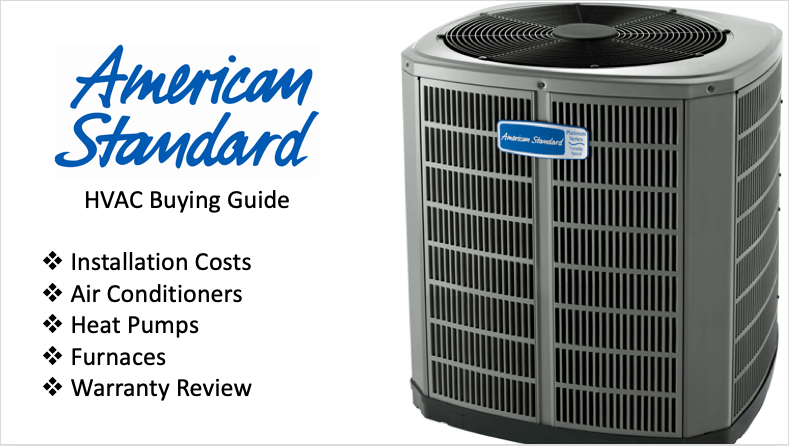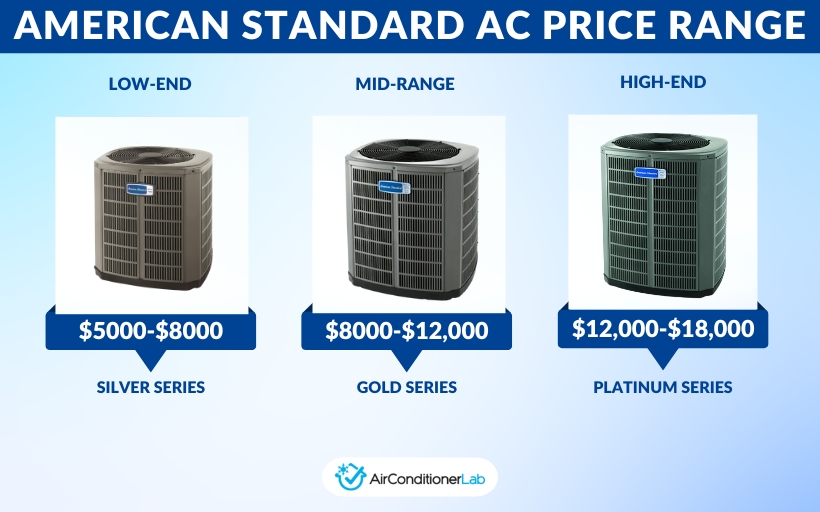American Standard Air Conditioner Prices

Understanding the cost of a new air conditioner can be daunting. If you're considering an American Standard unit, you've come to the right place. We'll break down the factors influencing price, different model options, and what to expect during installation. Remember, while some minor HVAC tasks are DIY-friendly, dealing with refrigerants or electrical components requires a certified professional.
Factors Affecting American Standard Air Conditioner Prices
Several key elements determine the final price of your American Standard air conditioner. Knowing these factors will help you budget effectively and choose the right system for your home.
- Unit Size (BTU): The cooling capacity of an AC is measured in British Thermal Units (BTU). Larger homes require higher BTU ratings, increasing the cost. A professional load calculation is essential to determine the correct size.
- SEER Rating: Seasonal Energy Efficiency Ratio (SEER) indicates the unit's energy efficiency. Higher SEER ratings mean lower energy bills but often come with a higher upfront cost. American Standard offers models across a range of SEER ratings.
- Model Type: American Standard offers various models, from basic single-stage units to advanced variable-speed systems. More advanced features mean higher prices.
- Installation Complexity: The difficulty of the installation can significantly impact the total cost. Replacing an existing unit is generally cheaper than installing a new system in a home without prior ductwork. Factors like accessibility to the outdoor unit and ductwork condition play a role.
- Labor Costs: HVAC technician labor rates vary by location and the company's experience. Getting quotes from multiple contractors is recommended.
- Permits and Fees: Local building codes often require permits for HVAC installations. These permits come with fees that are added to the overall cost.
- Ductwork: The condition and size of your existing ductwork can affect the price. You might need to repair, seal, or even replace the ductwork for optimal performance, adding to the cost.
- Additional Features: Smart thermostats, zoning systems, and air purification technologies can enhance your AC system but also increase the initial investment.
American Standard Air Conditioner Models and Price Ranges (Estimated)
Keep in mind these are approximate ranges. Contact your local American Standard dealer for accurate, personalized quotes.
Silver Series
The Silver Series is American Standard's entry-level line. These models offer a good balance of affordability and efficiency.
- SEER Rating: Typically ranges from 13 to 16 SEER.
- Features: Single-stage compressors, reliable performance.
- Price Range (Unit Only): $2,500 - $4,000
- Typical Installed Cost: $4,500 - $7,500
Gold Series
The Gold Series offers enhanced efficiency and features compared to the Silver Series. It's a mid-range option for homeowners looking for better performance.
- SEER Rating: Ranges from 16 to 18 SEER.
- Features: Single-stage or two-stage compressors, quieter operation.
- Price Range (Unit Only): $3,500 - $5,500
- Typical Installed Cost: $6,000 - $9,500
Platinum Series
The Platinum Series represents American Standard's premium line. These models offer the highest efficiency, advanced features, and the quietest operation.
- SEER Rating: Ranges from 18 to 22 SEER or higher.
- Features: Variable-speed compressors, advanced controls, exceptional comfort.
- Price Range (Unit Only): $5,000 - $8,000+
- Typical Installed Cost: $8,500 - $13,000+
Important Note: These prices are estimates and can vary widely depending on your location, the specific model chosen, installation complexity, and contractor pricing. Be sure to get multiple quotes for an accurate assessment.
Installation Costs Breakdown
The installation cost is a significant part of the total expense. Here's a breakdown of what you can expect:
- Unit Price: The cost of the American Standard air conditioner itself (as outlined above).
- Labor: The hourly rate for HVAC technicians. Expect to pay anywhere from $75 to $150 per hour, depending on your location and the contractor.
- Materials: This includes refrigerant, copper tubing, electrical wiring, ductwork connectors, and other necessary components.
- Permits: Fees for obtaining the required permits from your local municipality.
- Ductwork Modifications: If your existing ductwork needs repair, sealing, or replacement, this will add to the cost.
- Disposal of Old Unit: The cost of removing and disposing of your old air conditioner.
DIY vs. Professional Installation: When to Call an Expert
While some homeowners might be tempted to install an air conditioner themselves to save money, it's generally not recommended, especially for newer, complex systems. Here's why:
DIY Tasks (with caution):
- Changing Air Filters: A simple and essential maintenance task.
- Cleaning Outdoor Unit Coils: Removing debris from the outdoor condenser coils can improve efficiency. Turn off the power to the unit before cleaning. Use a fin comb to straighten bent fins carefully.
- Checking for Obvious Leaks: Visually inspect refrigerant lines for any signs of leaks (oil residue). Do NOT attempt to repair refrigerant leaks yourself. This requires specialized equipment and certification.
When to Call a Professional:
- Refrigerant Handling: Refrigerant is a controlled substance. Only certified technicians can legally handle it.
- Electrical Work: Air conditioners involve high-voltage electrical connections. Improper wiring can be dangerous and void warranties.
- Unit Installation: Correctly sizing, installing, and commissioning an AC unit requires specialized knowledge and tools. Improper installation can lead to inefficiency, premature failure, and void warranties.
- Ductwork Modifications: Proper ductwork design and installation are crucial for optimal airflow and efficiency.
- Troubleshooting Complex Issues: Diagnosing issues with the compressor, motor, or other components requires expertise and specialized equipment.
Safety First: Always turn off the power to the unit at the breaker before attempting any DIY maintenance. If you're unsure about anything, call a qualified HVAC technician.
Common American Standard Air Conditioner Problems
Even with proper maintenance, air conditioners can experience problems. Here are some common issues:
- Lack of Cooling: Could be due to a refrigerant leak, dirty coils, a faulty compressor, or a clogged air filter.
- Frozen Evaporator Coil: Often caused by restricted airflow, low refrigerant, or a malfunctioning blower motor.
- Noisy Operation: Can indicate a loose fan blade, a failing compressor, or a problem with the motor.
- Water Leaks: Often caused by a clogged condensate drain line.
- Short Cycling: The AC turns on and off frequently, which can be caused by an oversized unit, a dirty air filter, or a faulty thermostat.
- Blower Motor Issues: The blower motor circulates air. If it fails, you'll experience no airflow.
- Compressor Failure: The compressor is the heart of the AC. If it fails, the AC won't cool, and it's often a costly repair.
Troubleshooting Tip: Before calling a technician, check the thermostat settings, air filter, and circuit breaker. Sometimes, the solution is simple.
Maintenance Tips to Extend the Life of Your American Standard AC
Regular maintenance can significantly extend the lifespan of your American Standard air conditioner and improve its efficiency.
- Change Air Filters Regularly: At least every 1-3 months, or more often if you have pets or allergies.
- Clean Outdoor Unit Coils: Remove debris like leaves, grass clippings, and dirt.
- Inspect Condensate Drain Line: Pour a cup of diluted bleach down the drain line every few months to prevent clogs.
- Schedule Professional Maintenance: Have a qualified HVAC technician inspect and service your AC unit at least once a year.
- Keep Outdoor Unit Clear: Ensure there is at least 2-3 feet of clear space around the outdoor unit for proper airflow.
- Consider a Programmable Thermostat: This can help you optimize energy usage and reduce cooling costs.
By understanding the factors that influence American Standard air conditioner prices and following these maintenance tips, you can make an informed decision and ensure your system operates efficiently for years to come.










